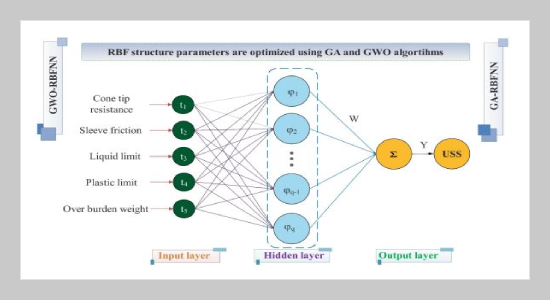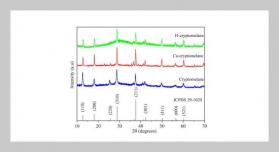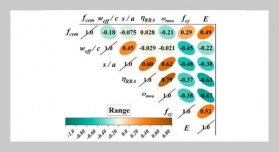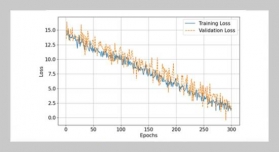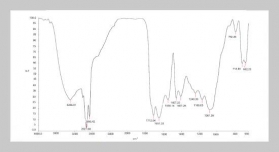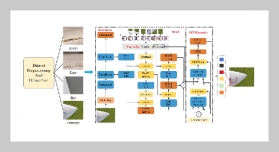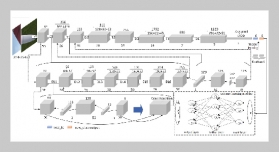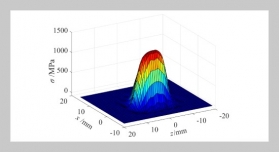Haojie Chen1, Gongxing Yan 1, Jie Li2, Haiyan Cui1, and Xiaolin Yao1
1School of Intelligent Construction, Luzhou vocational and technical college, Luzhou 646000, Sichuan, China
2School of Architectural Engineering, Chongqing Creation Vocational College, Yongchuan 402160, Chongqing, China
Received:
December 8, 2021
Accepted:
March 4, 2022
Publication Date:
April 15, 2022
Copyright The Author(s). This is an open access article distributed under the terms of the Creative Commons Attribution License (CC BY 4.0), which permits unrestricted use, distribution, and reproduction in any medium, provided the original author and source are cited.
Download Citation: ||https://doi.org/10.6180/jase.202301_26(1).0013
ABSTRACT
In this study, two hybrid metaheuristic models are developed to discover the applicability of using an optimized radial basis function neural network to predict the undrained shear strength (USS) from cone penetration test (CPT) records. To this aim, genetic algorithm (GA) and grey wolf optimization (GWO) were integrated with radial basis function (RBFNN), named GA-RBFNN and GWO-RBFNN, to determine the optimal determinative parameters of RBFNN. Models trained with five input variables named cone tip resistance, sleeve friction, liquid limit, plastic limit, and overburden weight. To assess the precision of developed models, four statistical performance indices (R2, RMSE, MAE, and PI) were considered. The results demonstrate powerful potential in the learning section as well as approximating in the testing phase. It means that the correlation between observed and predicted USS from hybrid models is acceptable to represent the high accuracy in the training and approximating process. Concerning developed RBFNN models, it can be observed that GWO-RBFNN has better performance than GA-RBFNN based on evaluating the performance evaluator indices. Based on the outline of this paper aimed at finding RBFNN optimal parameters with optimization algorithms, GWO is more capable and rapid than GA for determining these parameters. Therefore, GWO-RBFNN outperforms the GA-RBFNN model with a total ranking of 16, consequently being recognized as the proposed model.
Keywords:
Undrained Shear Strength of Soil; Cone Penetration Test; Prediction; Radial basis function; Grey Wolf Optimization; Genetic algorithm
REFERENCES
- [1] E.-F. M., K. H., and J. A., (2018) “Experimental study of the mechanical behavior of frozen soils - A case study of Tabriz Subway" Periodica Polytechnica Civil Engineering 62(1): 117–125. DOI: 10.3311/PPci.10960.
- [2] R. Sarkhani Benemaran, (2017) “Experimental and analytical study of pile-stabilized layered slopes" Tabriz: University of Tabriz:
- [3] P. A., E.-F. M., and K. H., (2021) “Pile-soil interaction determined by laterally loaded fixed head pile group" Geomechanics and Engineering 26(1): 13–25. DOI: 10.12989/gae.2021.26.1.013.
- [4] H. W., S. D., S. S.W., and Y. H.S., (2004) “Finite element analysis of cone penetration in cohesionless soil" Computers and Geotechnics 31(7): 517–528. DOI: 10.1016/j.compgeo.2004.09.001.
- [5] M. Esmaeili-Falak, H. Katebi, A. Javadi, and S. Rahimi, (2017) “Experimental investigation of stress and strain characteristics of frozen sandy soils-A case study of Tabriz subway" Modares Civil Engineering journal 17(5): 13–23.
- [6] M. Esmaeili-Falak. “Effect of system’s geometry on the stability of frozen wall in excavation of saturated granular soils". (phdthesis). Doctoral dissertation, University of Tabriz Tabriz, Iran, 2017.
- [7] M. Esmaeili Falak, R. Sarkhani Benemaran, and R. Seifi, (2020) “Improvement of the mechanical and durability parameters of construction concrete of the Qotursuyi Spa" Concrete Research 13(2): 119–134. DOI: 10.22124/JCR.2020.14518.1395.
- [8] A.-F. M., T. M., and V. G., (2003) “Numerical parametric study of piezocone penetration test in clays" International Journal of Geomechanics 3(2): 170–181. DOI: 10.1061/(ASCE)1532-3641(2003)3:2(170).
- [9] S. R., B. R.W., and M. J.K., (1997) “Lateral stress effects on CPT liquefaction resistance correlations" Journal of Geotechnical Engineering 123(8): 726–735. DOI: 10.1061/(ASCE)1090-0241(1997)123:8(726).
- [10] T. C.I. and H. G.T., (1991) “An analytical study of the cone penetration test in clay" Geotechnique 41(1): 17–34. DOI: 10.1680/geot.1991.41.1.17.
- [11] M. A. H. Mojumder, (2020) “Evaluation of undrained shear strength of soil, ultimate pile capacity and pile setup parameter from cone penetration test (CPT) using artificial neural network (ANN)":
- [12] L. Tom and K. Arne. “ROLE OF CPT IN NORTH SEA FOUNDATION ENGINEERING.” In: Cited by: 43.1981, 76–107.
- [13] K. Senneset, N. Janbu, and G. Svano, (1982) “Strength and deformation parameters from cone penetration tests. Proceedings of the European Symposium on Penetration Testing. ESOPT":
- [14] R. S. Benemaran and M. Esmaeili-Falak, (2020) “Optimization of cost and mechanical properties of concrete with admixtures using MARS and PSO" Computers and Concrete, An International Journal 26(4): 309–316. DOI: 10.12989/cac.2020.26.4.309.
- [15] D. S.K. and B. P.K., (2006) “Undrained lateral load capacity of piles in clay using artificial neural network" Computers and Geotechnics 33(8): 454–459. DOI: 10.1016/j.compgeo.2006.08.006.
- [16] E.-F. M., K. H., V. M., and A. J., (2019) “Predicting Triaxial Compressive Strength and Young’s Modulus of Frozen Sand Using Artificial Intelligence Methods" Journal of Cold Regions Engineering 33(3): DOI: 10.1061/(ASCE)CR.1943-5495.0000188.
- [17] I. S.B., A. M., V. M., and K. F., (2010) “Prediction of swelling pressures of expansive soils using artificial neural networks" Advances in Engineering Software 41(4): 647–655. DOI: 10.1016/j.advengsoft.2009.12.005.
- [18] P. N. F. and J. M.B., (2017) “Load-settlement behavior modeling of single piles using artificial neural networks and CPT data" Computers and Geotechnics 89: 9–21. DOI: 10.1016/j.compgeo.2017.04.003.
- [19] S. B. R., E.-F. M., and K. H., (2021) “Physical and numerical modelling of pile-stabilised saturated layered slopes" Proceedings of the Institution of Civil Engineers: Geotechnical Engineering: DOI: 10.1680/jgeen.20.00152.
- [20] Y. J., Z. M., and E.-F. M., (2022) “A comparative study on predicting the rapid chloride permeability of selfcompacting concrete using meta-heuristic algorithm and artificial intelligence techniques" Structural Concrete: DOI: 10.1002/suco.202100682.
- [21] Z. W., H. L., M. L., and E.-F. M., (2021) “Predicting the uniaxial compressive strength of oil palm shell lightweight aggregate concrete using artificial intelligence-based algorithms" Structural Concrete: DOI: 10.1002/suco.202100656.
- [22] P. Samui and P. Kurup, (2012) “Multivariate adaptive regression spline and least square support vector machine for prediction of undrained shear strength of clay" International Journal of Applied Metaheuristic Computing (IJAMC) 3(2): 33–42.
- [23] S. M.A., M. H.R., and J. M.B., (2002) “Predicting settlement of shallow foundations using neural networks" Journal of Geotechnical and Geoenvironmental Engineering 128(9): 785–793. DOI: 10.1061/(ASCE)1090-0241(2002)128:9(785).
- [24] A.-F. M.Y. and M. M.A.H., (2020) “Exploring Artificial Neural Network to Evaluate the Undrained Shear Strength of Soil from Cone Penetration Test Data" Transportation Research Record 2674(4): 11–22. DOI: 10.1177/0361198120912426.
- [25] Z. W., W. C., Z. H., L. Y., and W. L., (2021) “Prediction of undrained shear strength using extreme gradient boosting and random forest based on Bayesian optimization" Geoscience Frontiers 12(1): 469–477. DOI: 10.1016/j.gsf.2020.03.007.
- [26] M. S., M. S.M., and L. A., (2014) “GreyWolf Optimizer" Advances in Engineering Software 69: 46–61. DOI: 10.1016/j.advengsoft.2013.12.007.
- [27] J. H. Holland. Adaptation in natural and artificial systems: an introductory analysis with applications to biology, control, and artificial intelligence. MIT press, 1992.
- [28] N. D., K. T., K. P.S., and R. V.S. “Weight optimization of plane truss using genetic algorithm”. In: 263.3. Cited by: 5; All Open Access, Bronze Open Access. 2017. DOI: 10.1088/1757-899X/263/3/032015.
- [29] H. T., (1999) “Optimization of resource allocation and leveling using genetic algorithms" Journal of Construction Engineering and Management 125(3): 167–175. DOI: 10.1061/(ASCE)0733-9364(1999)125:3(167).
- [30] W. Sun, D. Liu, J.Wen, and Z.Wu, (2017) “Modeling of MEMS gyroscope random errors based on grey model and RBF neural network" J. Navig. Position 5: 9–13.
- [31] S. Seshagiri and H. K. Khalil, (2000) “Output feedback control of nonlinear systems using RBF neural networks" IEEE Transactions on Neural Networks 11(1): 69–79.


